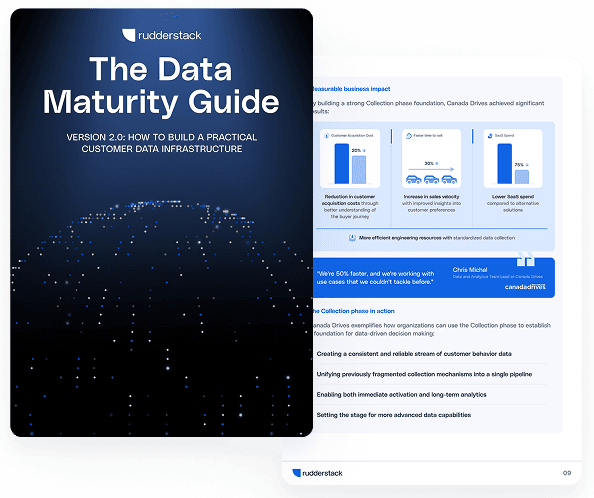Enterprise data integration: Importance, tools, and best practices

Most enterprises today are drowning in data, but starving for insight. Critical information lives across CRMs, ERPs, marketing platforms, and internal databases, making it nearly impossible to get a single, trusted view of the business. Without effective data integration, teams operate in silos, decisions are delayed, and opportunities are missed.
In this article, we'll break down what enterprise data integration is, why it matters, the tools and architectures that support it, and best practices to ensure your integration strategy scales with your business.
Main takeaways:
- Enterprise data integration unifies data from fragmented systems, such as CRMs, ERPs, and SaaS tools, into a single, accessible layer to eliminate silos and support real-time analytics.
- Modern integration architectures combine ETL/ELT pipelines, API-driven connections, and event streaming to support both batch and real-time use cases
- Cloud-native and iPaaS solutions offer scalable, low-maintenance integration options that fit seamlessly into modern data stacks
- Strong governance practices, such as schema validation, masking, and consent tracking, are essential for ensuring data quality, privacy, and regulatory compliance.
- Successful enterprise data integration starts with small, high-impact projects and scales through standardized patterns, stakeholder alignment, and continuous monitoring
What is enterprise data integration?
Enterprise data integration is the process of combining data from multiple sources across an organization into a unified, accessible format. This practice enables companies to break down silos and create a single source of truth for all business information.
Unlike simple data transfers, enterprise data integration connects diverse systems like CRMs, ERPs, databases, and SaaS applications. The goal is to make all relevant business data available where and when it's needed.
Most enterprises today struggle with complex technology stacks where valuable data is scattered. The integration of enterprise solutions ensures this data isn't isolated but instead supports analytics, reporting, and personalized customer experiences.
Key integration challenges: The most common hurdles in enterprise data integration are managing high data volumes, resolving quality issues, and ensuring system compatibility. In fact, over half of the respondents in a Wakefield Research survey said that poor data quality affected 25% or more of their revenue.
Why enterprise data integration matters
A unified approach to data integration helps organizations overcome the challenge of data silos. When data is trapped in isolated systems, teams can't see the complete picture, leading to missed opportunities and errors.
Integrating data enables better business agility. Teams can access up-to-date information for faster decision-making across departments.
Integration is essential for regulatory compliance. By centralizing and governing data, you reduce the risk of errors or privacy breaches.
- Business agility: Integrated data allows you to react quickly to market changes
- Customer experience: Unified profiles enable personalized interactions
- Operational efficiency: Eliminates redundant work and streamlines processes
- Compliance: Centralized control helps meet privacy and audit requirements
Key benefits for modern organizations
Integrating enterprise data systems unlocks a range of business-critical advantages. Here's how it impacts performance, decision-making, and long-term agility.
1. Faster access to insights
Enterprise data integration reduces the gap between data collection and analysis. Your teams can query and visualize unified data, speeding up reporting and operational decisions.
Business data integration enables real-time analytics that weren't possible with siloed systems. This means you can spot trends and respond to market changes faster than competitors.
2. Reduced operational silos
When departments share integrated data, collaboration improves naturally. Marketing, sales, finance, and product teams can all work from the same information, avoiding miscommunication.
Data integration business processes break down the walls between departments. This creates a more cohesive organization where decisions are based on shared information.
3. Improved data quality
Integration processes often include data cleaning and validation steps. This helps ensure your analytics and reports are based on accurate, consistent data.
Better data quality leads to more trustworthy insights. When everyone uses the same clean data source, you eliminate conflicting reports and metrics.
Data quality impact: According to Gartner, poor data quality costs organizations an average of $12.9 million per year. Integrating and governing data is a critical step to minimizing these losses.
Enterprise data integration methods and architectures
There's no one-size-fits-all approach to integration; here are the most common methods organizations use to connect their systems and manage data flow effectively.
1. ETL and ELT approaches
ETL (Extract, Transform, Load) moves data from source systems, transforms it into a target format, and loads it into a destination like a data warehouse. ELT (Extract, Load, Transform) loads data first, then transforms it within the destination.
ETL works best for structured data and legacy systems. ELT is ideal for large-scale, cloud-based analytics where you need flexibility.
| Feature | ETL | ELT |
|---|---|---|
| Processing location | Integration server | Data warehouse |
| Transformation timing | Before loading | After loading |
| Best for | Legacy, operational data | Big data, analytics |
| Scalability | Limited | High (cloud) |
2. API-driven integrations
APIs (Application Programming Interfaces) allow different software systems to exchange data in real time. This method is ideal for connecting SaaS tools, microservices, or enabling event-driven workflows.
Modern enterprise data integration services often use APIs as the primary connection method. They're flexible, scalable, and support real-time data exchange.
3. Data virtualization
Data virtualization creates a unified view of data across multiple sources without physically moving it. This is useful for real-time analytics or when data residency is a concern.
This approach reduces storage costs and simplifies compliance. Your data stays in its original location while still being accessible through a unified layer.
4. Event-driven pipelines
Event-driven integration uses real-time streams, such as customer interactions or IoT device data, to trigger updates across systems instantly. This method supports use cases requiring immediate response, like fraud detection or personalization.
Many enterprise data integration platform solutions now include event streaming capabilities. This lets you combine batch and real-time approaches in a single system.
How data integration works in practice
Enterprise data integration follows a series of steps to ensure reliable, high-quality outcomes:
- Data source identification: List all databases, applications, and external systems that generate business-critical data
- Data profiling: Assess data quality, formats, and any inconsistencies
- Schema mapping: Define relationships between different data models
- Transformation logic: Standardize, clean, and enrich data
- Implementation: Build pipelines that move and process data
- Testing: Check that the integrated data is accurate and complete
- Deployment and monitoring: Move to production and set up error detection
Ready to unify your enterprise data? See how RudderStack's cloud-native customer data infrastructure gives you full control and real-time access without sacrificing privacy. Request a demo
Essential tools and technologies for enterprise data integration
To support enterprise-scale integration, organizations rely on a range of tools and platforms that streamline data movement, transformation, and governance. These include:
1. Integration platforms and orchestration
Integration platforms help manage complex data flows across your organization. They can schedule, monitor, and automate pipelines, reducing manual work.
Enterprise data integration services typically include orchestration tools that coordinate multiple data flows. These ensure data moves efficiently between systems while maintaining consistency.
2. Cloud-native and iPaaS
Cloud-native integration tools and iPaaS (Integration Platform as a Service) run on scalable cloud infrastructure. They support fast deployment, dynamic scaling, and lower maintenance overhead.
Modern cloud-native solutions like RudderStack provide the technical foundation to unify event data without compromising on privacy or performance. They integrate with your existing data stack rather than creating new silos.
3. Real-time streaming tools
Real-time streaming tools process and deliver data as it's generated. This supports use cases like behavioral analytics, instant notifications, and real-time dashboards.
These tools are becoming essential components of modern integration enterprise architecture. They complement batch processing for a complete data strategy.
- Data integration platforms: Centralize and automate complex integrations
- ETL/ELT tools: Batch process large volumes for analytics
- API management: Control and secure connections between applications
- Message brokers: Enable event-driven architectures
- Data quality tools: Validate and clean data before it reaches analytics systems
Best practices for governance and privacy in data integration
Effective enterprise data integration depends on strong governance and privacy practices to ensure data security, compliance, and trust across all systems.
1. Schema validation and version control
Always validate schemas and track changes to your data structures. Version control ensures you can roll back or audit changes when needed.
This practice prevents data quality issues from spreading through your systems. It also creates accountability for data model changes.
2. Masking and anonymization
Mask or anonymize sensitive data as early as possible in your pipelines. This reduces exposure risk and supports privacy requirements.
These techniques are essential for compliance with regulations like GDPR and CCPA. They protect both your customers and your organization.
3. Consent management
Track user consent and data preferences across all sources. Ensure that only authorized data is processed or shared between systems.
Effective consent management is a cornerstone of ethical data use. It builds trust with customers while meeting regulatory requirements.
💡 Tip: Create a data catalog that documents all integrated data sources, their owners, sensitivity levels, and usage policies. This makes governance much more manageable.
4. Real-time streaming and cloud-native environments
Real-time streaming moves data instantly from source to destination. This enables immediate responses to business events, which is increasingly important for customer personalization and operational alerts.
Cloud-native architectures leverage the scalability of cloud services. They allow you to handle large data volumes and complex integrations efficiently.
Event streaming is a key enabler of modern business data integration. It makes it possible to unify customer data, product usage, and transactional records in real time.
RudderStack supports real-time delivery to your warehouse and downstream tools. This maintains governance across all environments while enabling immediate data activation.
Overcoming challenges and ensuring success in enterprise data integration
Even the best integration plans face roadblocks; understanding and proactively addressing these challenges is key to long-term success.
1. Handling large data volumes
Use scalable, cloud-native tools that automatically adapt to data growth. Partitioning and parallel processing help manage heavy loads.
Enterprise data integration platform solutions should be evaluated based on their ability to scale. Look for options that grow with your business without performance degradation.
2. Navigating legacy systems
Bridge old and new systems with adapters or middleware. Focus on extracting only the data you need for modern analytics.
Many organizations struggle with legacy integration. The right enterprise data integration services can help create connectors that work with older systems.
3. Gaining stakeholder buy-in
Showcase quick wins by starting with high-impact integration projects. Communicate the business value and involve stakeholders early in the process.
- Start small: Begin with high-value, manageable integration projects
- Measure outcomes: Track and communicate integration benefits
- Build skills: Develop internal expertise in integration technologies
- Standardize processes: Create repeatable integration patterns
Unify enterprise data with RudderStack
Modern enterprise teams can't afford slow, fragmented data. With the right integration strategy, you can eliminate silos, boost data quality, and deliver insights at the speed of your business. But doing it right means more than just moving data—it means building governance in from day one. Schema validation, consent tracking, and privacy controls aren’t optional—they're essential.
That's where RudderStack comes in. Our customer data infrastructure gives you full control over your pipelines—real-time and batch—without vendor lock-in or surprise bottlenecks. Whether you're syncing data from your CRM, product stack, or marketing tools, RudderStack helps you unify, govern, and activate your data—all in one place.
See what your data can really do. Request a demo and learn how RudderStack helps you unify enterprise data at scale, without compromising flexibility or control.
FAQs about enterprise data integration
Why is data integration needed in an enterprise?
Data integration is needed to break down silos, enable unified analytics, and ensure all teams work with accurate, consistent information across the organization.
How do I measure the ROI of my enterprise data integration projects?
Measure ROI by tracking improvements in decision speed, reduced manual work, higher data quality, and improved compliance compared to pre-integration metrics.
What are the most secure methods for integrating sensitive data across systems?
The most secure integration methods include encrypted data pipelines, field-level masking of PII, role-based access controls, and audit logging for all data movements between systems.
Published:
July 9, 2025

Data collection crossroads: When to use RudderStack or Google Tag Manager (or both)
In this post, we’ll review three options for how to implement RudderStack with Google Tag Manager, based on experience we’ve gathered across thousands of implementations.

Data integration framework: Components and best practices
A well-designed data integration framework can unify your data architecture, enabling automated pipelines, reducing inconsistencies, and providing a single source of truth for analytics and operations.

Webhook vs. API: What's the difference and when to use each?
Learn when to use APIs vs webhooks for customer data integrations. Compare pull vs push models, tradeoffs in latency, reliability, and control, and how combining both with RudderStack delivers real-time, flexible data flows.






